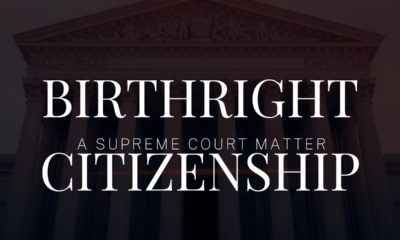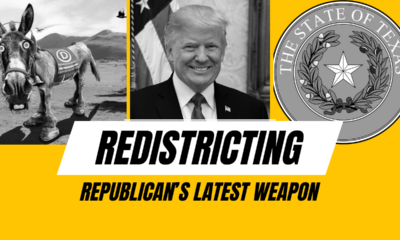Constitution
Idaho Senate committee takes up invitation
A committee of the Idaho Senate takes up an invitation to Oregon’s eastern counties to join the Gem State. Will the Senate say yes?
In the week to come, the Committee for State Affairs in the Idaho Senate will take up HJM 1. This is the instrument of negotiation with Oregon for moving their shared border to the Cascade Mountains. In other words, this is the instrument of invitation to Oregon’s eastern counties to join Idaho. Now the Greater Idaho Movement is campaigning heavily within Idaho to convince enough Senators to act.
Details of Idaho measure
The Idaho House of Representatives passed House Joint Memorial 1 (HJM 1) on February 15. The next day, the Idaho Senate received the bill, gave it first reading, and referred it to the State Affairs Committee.
The idea of the eastern two-thirds of Oregon joining Idaho has received a great deal of media attention. Most of that attention has come on the Oregon side. KGW-TV (Channel 8, Portland, NBC) seems worried about the prospect. They took note that Douglas and Josephine Counties voted against secession. But among the possible reasons were that those minded to secede, really want to carve out a “State of Jefferson” to include southern Oregon and some counties in northern California. Originally the Greater Idaho movement wanted all those counties to join Idaho, with the counties east of the Cascades. (Greater Idaho hasn’t given up on them; they’ve merely reclassified the larger expansion as Phase II.)
In addition, former Oregon gubernatorial candidate Betsy Johnson speaks of “real, visceral anger” throughout the eastern counties. Perhaps the stifling of economic development, and the allowance of hallucinogens (marijuana and psilocybin or “Magic Mushrooms”) might explain part of it. Oregon’s vision for public-education curriculum also looms large. Very few counties east of the Cascades voted for any of it.
Station KOIN-TV (Channel 6, Portland, CBS) points out that if the eastern counties secede, they will take with them three of the Seven Wonders of Oregon. Specifically, Oregon would lose the Painted Hills, Smith Rock and The Wallowas.
What’s in it for Idaho?
The Greater Idaho movement recently released a video for consumption by Idaho residents.
The pitch on the Idaho side comes down to these points:
The Gem State would nearly double in size but receive only 21 percent more people. That would give Idahoans – and more to the point, newcomers – room to live. Already the State is full of refugees from “blue States,” and real-estate developers are buying farms and subdividing them for new homes. Eastern Oregon would represent much more wide-open space. The Gem State would have the land area of Montana but twice its population.
The new residents would share the conservative values of the State they wish to join. Republicans routinely capture 75 percent of the vote in those counties, and 67 percent of the vote in Idaho proper. More to the point, those residents would welcome the enforcement of Idaho laws against the newly legalized hallucinogens. Available drugs would be a five-hour drive from Boise, whereas they are 41 minutes away today.
Eastern Oregon does have more than its share of Medicaid recipients. But many of those would not be eligible under current Idaho law. And that same body of law would let the eastern counties thrive. Simply put, the Salem-Portland-Eugene axis has forced the eastern counties to leave certain resources – especially fossil fuels – in the ground, while letting them grow marijuana and “Magic Mushrooms” instead. Following the annexation, that would reverse.
More media attention
In fact, KPTV (Channel 12, Portland, Fox) gave attention to former Oregon House Speaker Mark Simmons’ op-ed in The Idaho Statesman.
Idaho would have the satisfaction of freeing rural, conservative communities from progressive blue-state law.
The Gem State would have more than satisfaction, said Simmons. He reiterated Greater Idaho’s claim that the annexation would stop the sale of drugs in the eastern counties. That kind of commerce, the eastern residents do not want. Nor do they want to pay the taxes to pay a $1000 monthly stipend to homeless people and low-income earners. Oregon’s legislature is considering a law to that very effect.
In light of that, Fox and Friends invited Rep. Barbara Ehart (R-Idaho Falls) to talk about HJM 1.
Rep. Ehart echoed much of Greater Idaho’s pitch.
The Senate will be a tougher sell. Perhaps not as many Senators, in proportion to the full Senate, see the advantages of the acquisition as clearly as Rep. Ehart laid it out in the House. Undaunted, Greater Idaho has targeted several State Senators for contact to urge them to vote to move HJM 1 to the full Senate. The State Affairs Committee should vote in the week to come.
About the map
The map shows what Idaho south of the current Washington-Oregon border would look like after the Phase I annexation.
Terry A. Hurlbut has been a student of politics, philosophy, and science for more than 35 years. He is a graduate of Yale College and has served as a physician-level laboratory administrator in a 250-bed community hospital. He also is a serious student of the Bible, is conversant in its two primary original languages, and has followed the creation-science movement closely since 1993.
-

 Civilization2 days ago
Civilization2 days agoDC Pipe Bomb Arrest Raises Questions About Christopher’s Wray’s FBI
-

 Civilization5 days ago
Civilization5 days agoYoo Hoo, VP Vance—Your Character is Showing!
-

 Executive5 days ago
Executive5 days agoThe Last Supper: New York’s Socialist Feast
-

 Guest Columns4 days ago
Guest Columns4 days agoCongressional Leaders See Far Higher Stock Returns Than Peers
-

 Civilization3 days ago
Civilization3 days agoThe Legal Logic Behind U.S. Operations Against Narco-Terrorist Networks
-

 Civilization5 days ago
Civilization5 days agoFacing Facts & Rolling Back Mythologies: The New National Security Strategy
-

 Civilization4 days ago
Civilization4 days agoHow Trump Changed America
-

 Executive3 days ago
Executive3 days agoNewsom’s ‘National Model’ for Homeless Wracked by Fraud














